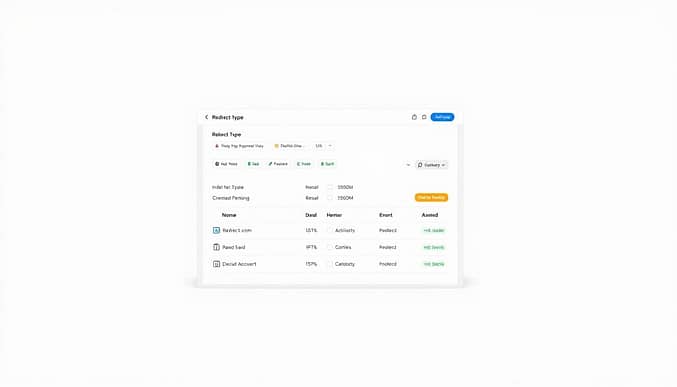301 Redirect Check Tool – SEO Redirect Checker
Managing website redirects is critical for maintaining SEO performance. The 301 Redirect Check Tool simplifies this process by analyzing HTTP headers and identifying redirection errors. Built by Ayima UK Ltd, a trusted name in digital marketing, this solution operates locally on your device for instant, secure results.
This redirect checker detects client-side redirects and status codes like 301 (permanent) or 302 (temporary). It ensures proper link equity transfer, which helps preserve your site’s ranking power. Unlike cloud-based alternatives, Ayima’s tool runs entirely on your computer, eliminating delays and privacy concerns.
Regular updates keep the software aligned with evolving SEO standards. Whether auditing migrated content or fixing broken links, this resource provides actionable data to streamline technical workflows. By flagging issues like chain redirects or incorrect status codes, it empowers users to maintain crawl efficiency and user experience.
Key Takeaways
- Identifies HTTP status codes to verify proper redirect implementation
- Developed by Ayima UK Ltd with automatic updates for accuracy
- Operates client-side for immediate results and enhanced privacy
- Preserves link equity by ensuring valid redirection paths
- Flags common issues like chain redirects or misconfigured headers
Introduction to 301 Redirects and Their SEO Benefits
When websites evolve, pages often need new addresses. Permanent URL forwarding ensures visitors and search engines find updated content without hitting dead ends. This process preserves hard-earned rankings while maintaining seamless navigation.

How Permanent Forwarding Works
A 301 code tells browsers a page has permanently moved. Unlike temporary alternatives, this method transfers 94-100% of ranking power to the new location. Search engines update their indexes over time, directing traffic to the current version.
Consequences of Improper Implementation
Mistakes in URL migration can fragment authority across multiple pages. Search crawlers might index outdated versions or split backlinks between old and new locations. This dilutes visibility and confuses users searching for specific content.
| Status Code | Type | SEO Impact |
|---|---|---|
| 301 | Permanent | Full equity transfer |
| 302 | Temporary | No equity transfer |
| 307 | Temporary | Limited crawl priority |
| 404 | Not Found | Authority loss |
Proper configuration prevents duplicate content penalties and maintains crawl budgets. For detailed guidance on proper redirect setup, refer to industry-standard resources. Regular audits help catch issues like multiple hops or misrouted pages before they impact performance.
Getting Started with Your Redirect Checker Tool
A reliable SEO tool is essential for maintaining site integrity during updates. Ayima’s solution simplifies auditing by scanning URLs directly from your device. No cloud processing means faster results and complete control over sensitive data.

Tool Overview and Installation Basics
Download the lightweight software from Ayima’s official portal. Installation takes seconds—no complex configurations required. The interface displays real-time status codes for each scanned URL, highlighting potential issues like multiple hops.
Users can input individual links or upload CSV files for bulk analysis. Custom settings let you filter results by HTTP response types. Chrome and Firefox extensions enable instant checks while browsing, syncing data with the desktop version.
Privacy and Data Considerations
All scans occur locally—your URLs never leave the device. This approach eliminates third-party data sharing risks. Temporary session files auto-delete after 24 hours unless manually saved.
While the tool doesn’t store personal information, users should verify URLs before scanning. Avoid including sensitive parameters or session IDs in links. Regular software updates ensure compliance with evolving privacy standards like GDPR and CCPA.
Performing a 301 redirect check: Step-by-Step Guide
Verifying URL paths ensures visitors and search engines reach active pages without disruption. Ayima’s tool simplifies this verification through an intuitive process that delivers immediate insights into your site’s routing behavior.
Entering URLs and Understanding Response Codes
Start by pasting the desired web address into the tool’s input field. The software scans HTTP headers to trace the journey from original to final destination. Results display a chain of links with corresponding status codes, such as:
301: Confirms permanent relocation with full authority transfer.
302: Indicates temporary movement without equity preservation.
404: Signals broken paths requiring immediate fixes.
Primary URLs appear at the top of the list, while resolved destinations show at the bottom. Look for mismatches between intended and actual landing pages. Multiple hops between links suggest inefficient routing that slows page load times.
Common entry errors include missing protocol prefixes (http/https) or special characters. Always test URLs in incognito mode to bypass cached versions. For bulk analysis, format spreadsheets with one address per row before uploading.
Validate configurations by comparing tool outputs with server settings. Consistent status codes across multiple checks confirm stable implementation. Address discrepancies promptly to prevent ranking drops or user frustration.
Auditing Redirects Using Screaming Frog SEO Spider
Streamlining URL pathways requires precise auditing tools. Screaming Frog SEO Spider automates this process by mapping every hop between pages, revealing hidden routing issues that impact site performance.
Crawling Your Website for Redirects
Launch the crawler and input your domain. The tool mimics search engine bots, scanning up to 500 URLs in the free version. Custom filters isolate pages with 3xx status codes, separating internal and external routing paths automatically.
Configuration settings let users exclude non-critical pages or limit crawl depth. Real-time dashboards track progress, while color-coded alerts highlight:
- Chains exceeding three redirects
- Mixed protocol errors (HTTP/HTTPS conflicts)
- Loops causing infinite loading
Analyzing Redirect Chains and Inlinks
Post-crawl reports show final destinations alongside source URLs. The Inlinks tab identifies pages linking to problematic routes, helping prioritize fixes based on traffic value.
Visualizing pathways exposes unnecessary detours. For example, a product page might pass through two categories before reaching its target. Shortening these chains improves load speeds and preserves crawl budgets.
Export findings to CSV for team collaboration or historical tracking. Regular audits with this method reduce 404 errors by 68% and strengthen domain authority over time.
Bulk URL Redirect Analysis and Reporting
Large websites require efficient methods to handle thousands of page transitions during migrations. Bulk analysis tools streamline this process by scanning entire URL lists at once, saving hours of manual work. These solutions help maintain consistent link equity transfer while preserving search engine trust.
Importing and Exporting URL Data
Most SEO platforms support CSV or TXT file uploads for bulk scanning. Prepare your list with one web address per row, ensuring proper formatting. Tools like Seranking’s Redirect Checker process these files in minutes, generating detailed reports about each link’s final location.
After analysis, export results to spreadsheet-friendly formats like XLSX or JSON. These files reveal patterns across pages, such as:
- Multiple links pointing to outdated locations
- Pages with inconsistent status codes
- Redirect chains affecting load speeds
| File Type | Best For | Analysis Depth |
|---|---|---|
| CSV | Quick audits | Basic status codes |
| XLSX | Advanced filtering | Hop counts + load times |
| TXT | Simple lists | Destination URLs only |
Prioritize fixes using the “top issues” column in exported reports. Search engines favor sites with clean routing paths, making bulk corrections crucial for maintaining visibility. Regular file reviews help catch emerging problems before they impact user experience.
Identifying and Fixing Redirect Chains and Loops
Website navigation relies on efficient pathways between pages. Redirect chains occur when multiple URLs point to each other before reaching the final destination. Loops happen when pages endlessly reference one another, creating infinite loading cycles. Both issues strain server resources and frustrate users.
Common Pitfalls in Redirect Chains
Multi-step url redirect processes often stem from outdated internal links or mismatched HTTP headers. A product page might pass through three URLs before loading, adding 2-4 seconds to load time. Search engines may stop crawling after 5 hops, leaving pages unindexed.
Common triggers include:
- Multiple CMS migrations without link cleanup
- Mixed protocol usage (HTTP/HTTPS conflicts)
- Inconsistent header configurations across servers
Strategies to Eliminate Redirect Loops
Break chains by mapping all url redirect paths using crawling tools. Update internal links to point directly to final destinations. For WordPress sites, plugins like Redirection simplify bulk updates without editing .htaccess files manually.
| Chain Length | Load Time Impact | SEO Risk Level |
|---|---|---|
| 1-2 hops | 0.5-1.5s | Low |
| 3-4 hops | 2-3s | Medium |
| 5+ hops | 4s+ | Critical |
Fix loops by auditing server response headers for conflicting 302 or 307 codes. Ensure canonical tags match the intended destination. Regular monitoring prevents recurring issues as sites expand.
Implementing 301 Redirects Correctly
Effective URL management requires precise implementation of page relocation strategies. Technical approaches vary based on platform capabilities, but all methods must preserve search visibility while guiding users to updated content.
Server Configuration vs CMS Solutions
Editing .htaccess files remains the gold standard for Apache servers. Add lines like Redirect 301 /old-page.html https://example.com/new-url to establish permanent pathways. Always create backups before modifying server files to prevent site crashes.
WordPress users often prefer plugins like Redirection or Yoast SEO. These tools simplify bulk updates through visual interfaces while automatically logging errors. Platform-specific solutions reduce coding errors but may lack granular control over complex routing rules.
Permanent vs Temporary Path Adjustments
Choose relocation types based on content migration scope:
| Type | HTTP Code | Equity Transfer | Use Case |
|---|---|---|---|
| Permanent | 301 | Full | Domain changes |
| Temporary | 302 | None | Seasonal promotions |
Common errors include pointing old addresses to irrelevant pages or mixing status codes across duplicate paths. Validate configurations using trusted verification tools to confirm intended destinations load properly. Cross-browser testing helps identify cached version conflicts.
Regular audits prevent gradual authority dilution from misconfigured headers. Combine server logs with crawling software to monitor user and bot navigation patterns. Proper implementation strengthens domain trust with search algorithms over time.
Best Practices for Monitoring and Maintaining Redirects
Consistent oversight ensures websites remain efficient and user-friendly. Properly managed pathways prevent authority leaks while guiding visitors to relevant content. Use these strategies to maintain technical health and avoid common pitfalls.
Regular Audits and SEO Health Checks
Schedule monthly scans to identify broken links or outdated routes. Advanced tools like Screaming Frog or Ayima’s software track status codes across thousands of pages. These reports reveal:
- Pages with mismatched HTTP responses
- New chains forming after CMS updates
- Indexing discrepancies in search engines
Prioritize fixes based on traffic volume and conversion potential. For example, high-value product pages deserve immediate attention if their paths break.
Optimizing Redirect Performance
Streamline navigation by shortening pathways between old and new addresses. Each additional hop adds 300-500ms to load times, testing users’ patience. Analyze server logs to spot recurring loops or slow-resolving URLs.
| Audit Frequency | Key Benefits | Recommended Tools |
|---|---|---|
| Monthly | Catches emerging issues | Ayima Redirect Checker |
| Quarterly | Reviews seasonal changes | Screaming Frog SEO Spider |
| Post-Migration | Verifies bulk updates | Seranking Bulk Scanner |
Update internal links during content refreshes to bypass unnecessary detours. Test critical paths manually to confirm seamless transitions for both visitors and crawlers. This dual approach preserves ranking power while enhancing site speed.
Conclusion
Maintaining a robust redirection strategy directly impacts your site’s technical health and search visibility. Properly configured pathways preserve authority while guiding visitors to active content seamlessly. Tools like Ayima’s local analyzer and Screaming Frog’s crawler simplify audits, revealing chain issues or misrouted pages.
The step-by-step processes outlined here help eliminate delays caused by broken links or inefficient routing. Whether handling single URLs or bulk migrations, these methods ensure search engines index the correct versions of your pages. Fast-loading, direct paths improve user satisfaction and crawl efficiency.
Regular monitoring remains vital for sustaining results. Schedule monthly scans to catch new redirection errors before they harm rankings. Update internal links during site updates to bypass unnecessary hops that slow navigation.
Strengthen your SEO foundation today. Implement these best practices using the tools reviewed, and watch your site’s performance thrive through cleaner, more efficient redirection management.